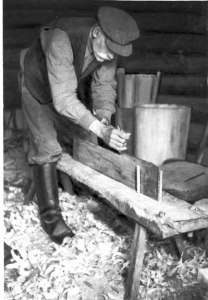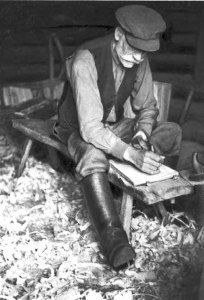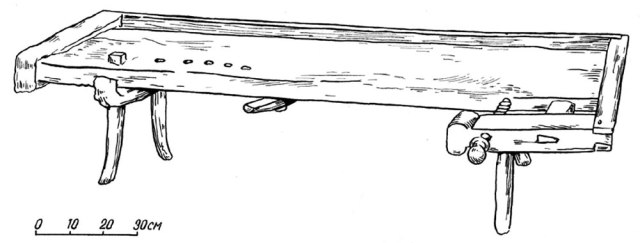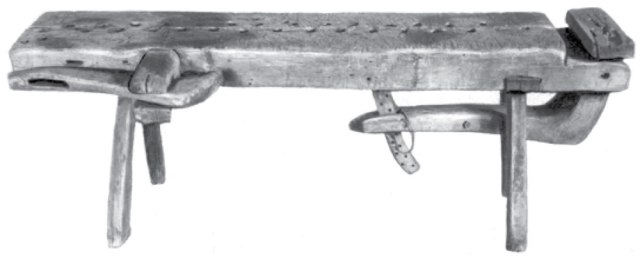This is an excerpt from “Woodworking in Estonia” by Ants Viires; translation by Mart Aru.

The use of the plane presumes a base on which the item being planed is fastened. For a long time a simple low working bench, in Avinurme, “tööjärg” (Fig. 56) served for this and on which also other woodwork was done. In places such benches are still used, particularly in Avinurme or elsewhere where home industry has persevered. The older generation throughout the country still remembers planing on the simple bench. The typical Avinurme workbench has two holes at one of its ends, and the board to be planed is fastened either against or between pegs driven in these holes, so that the person planing sits astride on the bench (Fig. 57). In other places there is often only one stick at the end of the bench. Mostly there are two holes next to each other near the middle of the bench and the board is fastened on the bench so it is possible to plane the edge of the board (Fig. 58). Sometimes there is a square hole in the center for the inverted wedge when holding the plane steady and jointing the edge of a board (see Fig. 94).


Such simple workbenches were still usual for Russian home-industry workers at the beginning of the past century. It also appears from representations of Nuremberg cabinetmakers from 1398 and 1444 that they, too, have used identical benches. Only in German drawings of the 16th century do we see higher and wider benches, although still simpler and more primitive than the benches known today. But in the 18th century, benches as represented in drawings and lithographs bear resemblance to the present-day bench.
So the carpenter’s bench (“höövlipink,” also “kruupink, tisleripink, puusepa pink”) as we know it today is no older that two or three centuries. It became known in the village later still, and its actual appearance can be placed within living memory of the older generation, i.e. at the end of the 19th century. Of course, there may have been estate carpenters who had acquired benches somewhat earlier, even a century or more. The rapid development of village cabinetmaking in the second half of the 19th century brought the bench into the village. The story of carpenter Juhan Kaseoks (born 1866) of Keila is characteristic:
“I didn’t have a carpenter’s bench earlier. About 30 years later [1910] there was a little more. Ikmelt Jaan’s father, whose name was Prits, he made the first one. His father was as a very good carpenter. He even started to sell them. Masters bought them from him. I was working at the manor, I naturally had one too. My father-in-law, Maerus, did that work, and he had one too. But households didn’t have them. There was a bench instead of it.”


So the carpenter’s bench developed into a generally obligatory carpentry tool. Only the Avinurme woodworkers who make wooden containers still use the old benches. Chairmaking joiners in Avinurme, however, use the up-to-date joiner’s bench.
— MB